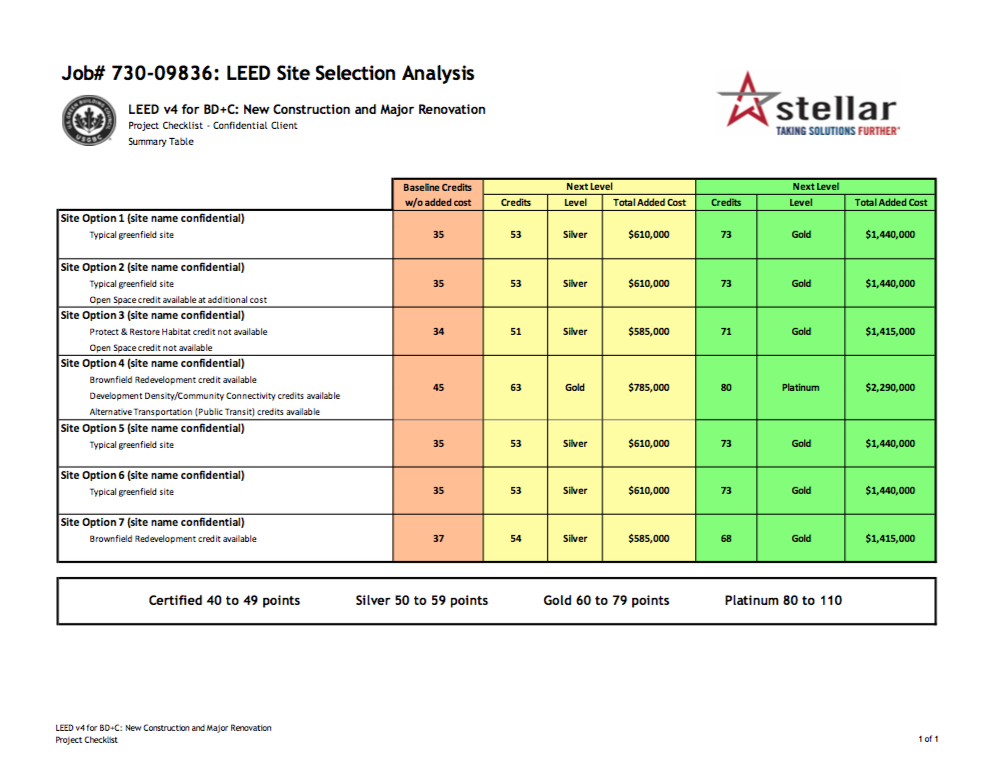When it comes to earning LEED certification, the location of your building plays a major role. After all, site selection accounts for 26 out of a possible 110 credits under LEED v4 New Construction — that’s more than halfway to the 50 credits required to achieve LEED Silver status.
A variety of factors determine whether your site is eligible for certain credits. Many times, simply looking 10 feet beyond the city limit and into county land can make a dramatic difference in cost or eligibility to earn certain credits.
Urban sites offer many “given” points that don’t require site modifications, such as access to public transit, but property near a city center is often more expensive. On the other hand, “paid” points that involve investing in site modifications — such as Sustainable Sites credits — realistically require a larger piece of land, which is often hard to find near a downtown area.
Sometimes, the money saved in land purchase costs can outweigh the costs associated with “paid” points. (Later in the post, we provide an example of a chart Stellar provides clients to help them make educated decisions about site selection for proposed facilities.)
Ultimately, narrowing down the best site for your facility comes down to your priorities, budget, LEED goals, and weighing the pros and cons of different locations.
In LEED v4, however, there are some stricter requirements for site selection credits that make them less easy to achieve compared to previous years. After all, LEED stands for Leadership in Energy and Environmental Design. As technology continues to develop and everyone moves towards being more “green,” the USGBC is making certifications more challenging in order to maintain its high standards for industry leadership.
Let’s look at the three biggest changes to site selection credits that you should consider if it’s been a while since your last LEED application.
1. Bicycle facilities
Achieving this credit may require substantial investment and planning, especially for a credit that is only worth one point. Previously, it was an easier decision for companies who value providing employees with bicycle facilities as part of the corporate culture and philosophy, but in v4, this is insufficient.
In the past, earning this credit only required bike storage and showering facilities. Under LEED v4, facilities must still have similar on-site amenities, but now off-site infrastructure via on-street bike lanes and proximity to diverse uses/public transportation are also required to earn this credit.
2. Green vehicles
This used to be a “given” point in previous versions of LEED: All you had to do was designate preferred parking spaces for green vehicles with signage. However, LEED v4 now requires that facilities also provide either electrical vehicle supply equipment (EVSE) charging stations for electric vehicles or alternative fueling facilities in addition to preferred spaces.
3. Rainwater management
In previous versions of LEED, earning this credit required basic control of peak stormwater runoff that was already almost universally required by the Authority Having Jurisdiction (AHJ) and automatically designed into the project.
However, achieving this credit in LEED v4 is now more challenging and expensive because it requires the once optional incorporation of low-impact development (LID) into the design of a facility. LID’s goal is to mimic a site’s pre-development hydrology by using design techniques that infiltrate, filter, store, evaporate and retain stormwater runoff close to its source.
Section 438 of the Energy Independence and Security Act of 2007 requires all federal facilities to incorporate LID, and LEED followed suit in v4. To meet this requirement, you must now store, without discharge, the entire volume of stormwater runoff for the “95% rainfall event.”
Retaining that much water requires substantial space and improvements to the landscape and soil to create a bioretention basin on the property, which is primarily why achieving this credit is now more expensive.
Balancing act: Choosing the best site for your facility
Of course, there’s more to selecting a site than just meeting LEED credits. Other critical components to consider include:
- Local taxes and utility rates
- Available labor market
- Local property incentives
- Transportation routes
That’s why it’s critical to partner with experts who can help analyze these factors and who have experience helping owners navigate these decisions.
At Stellar, we often prepare a document like the sample shown below, which breaks down the potential and cost of achieving different LEED levels for various sites that a client is considering.

The baseline credits column shows the “free” or “given” credits that the site qualifies for without making any modifications. You can then easily see what the financial investment would be to achieve the next two levels of LEED certification for each of the potential sites.
Again, there are a lot of factors to weigh when it comes down to site selection, and it ultimately comes down to your priorities, budget and goals. An experienced firm can help you with the balancing act of weighing LEED potential and other site selection factors when planning for a new facility.



